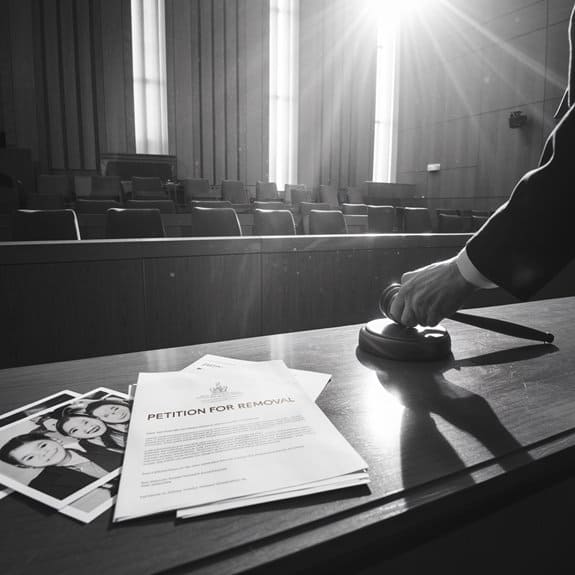
In BC, you can petition the Supreme Court to remove an executor or trustee who has breached their fiduciary duties. Valid grounds include misconduct, incapacity, conflict of interest, or hostility toward beneficiaries that endangers estate assets. You will need substantial evidence documenting the breach, including financial records and correspondence. The court prioritizes beneficiaries’ welfare but will not remove trustees without clear proof of misconduct. The sections below outline the complete legal process and requirements.
Legal Foundation for Executor and Trustee Removal in British Columbia
When faced with an executor or trustee who fails to fulfill their duties properly, British Columbia law provides specific mechanisms for their removal.
The primary legal framework comes from two key statutes: Sections 158 and 159 of the Wills, Estates and Succession Act (WESA) for executors, and Sections 30 and 31 of the Trustee Act for trustees.
These laws empower the BC Supreme Court to remove individuals who are endangering estate assets, demonstrating dishonesty, lacking proper capacity, or failing to maintain reasonable fidelity to their obligations.
The court’s discretion in these matters always prioritizes the collective welfare of beneficiaries rather than individual interests.
You will need substantial evidence of misconduct or incapacity to persuade the court, as removal is not undertaken lightly.
Understanding the Fiduciary Role: Duties and Responsibilities
At the core of every estate administration or trust management lies the fiduciary relationship between the appointed individual and the beneficiaries. This relationship demands the highest standards of loyalty, care, and honesty. As a fiduciary, your executor or trustee must always act in the beneficiaries’ best interests, not their own.
- Preserve and protect estate assets by securing property, managing investments prudently, and preventing value deterioration.
- Maintain detailed financial records of all transactions and be prepared to account for every decision made.
- Distribute assets according to the will or trust document’s instructions, treating all beneficiaries with equal consideration.
Understanding these responsibilities is essential when evaluating whether an executor or trustee has failed in their duties to the point where removal might be necessary.
Key Grounds for Executor Removal Under BC Law
British Columbia law establishes specific grounds upon which the court may remove an executor or trustee who fails to fulfill their fiduciary obligations.
Under sections 158-159 of the Wills, Estates and Succession Act and sections 30-31 of the Trustee Act, removal can be justified when evidence shows endangerment of estate property or dishonesty.
You can seek executor removal if they have demonstrated incapacity to perform duties, significant conflict of interest, or lack of reasonable fidelity.
Courts also consider substantial animosity toward beneficiaries that impairs judgment, as seen in Rawji Estate (2023).
Misconduct such as lack of neutrality, failure to disclose information, or treating beneficiaries with hostility constitutes valid grounds, as established in Kyle Estate v. Kyle (2016).
While technical breaches alone are typically insufficient, actions that consistently harm beneficiaries’ interests can warrant displacement.
Evidence Required to Support Removal Applications
Successfully challenging an executor’s appointment requires substantial evidence that meets the high threshold established by BC courts.
You will need to demonstrate that the executor’s conduct clearly endangers the estate or shows a fundamental inability to perform their duties. Documentation is critical—courts will not remove an executor based on vague allegations or minor disputes.
- Financial records showing misappropriation, unauthorized transactions, or neglect
- Correspondence revealing hostility, bias, or refusal to communicate with beneficiaries
- Expert testimony or assessments proving the executor’s incapacity or incompetence
Remember that timing matters; act promptly when you discover potential misconduct.
Courts consider delay in bringing an application as a factor that may weaken your case. Your evidence must directly connect the executor’s actions to actual harm or serious risk to the estate’s administration.
The Court Application Process: Steps and Documentation
Once you have gathered sufficient evidence of an executor’s misconduct, the formal court application process begins.
You will need to file a petition in the BC Supreme Court, which must include affidavits detailing the grounds for removal, supporting evidence, and relevant case law.
Your application should clearly identify the executor or trustee, outline their specific failures or misconduct, and explain how these actions harm the estate or beneficiaries.
Include all relevant documentation such as the will, trust documents, financial records, and correspondence demonstrating the executor’s improper conduct.
You must serve all interested parties with notice of your application, including beneficiaries and the executor in question.
The court will then schedule a hearing where both sides can present arguments before a judge makes the final determination.
Case Studies: Successful Executor Removals in BC Courts
- Kyle Estate v. Kyle established that misconduct including lack of neutrality and hostile treatment of beneficiaries warrants removal.
- Jury v. Rogodzinski confirmed that clear conflicts of interest between personal interests and executor duties justify displacement.
- Unreasonable delays leading to estate value erosion have consistently supported successful removal applications.
Conflict of Interest: When Personal Interests Compromise Estate Management
A serious conflict of interest arises when an executor’s personal interests directly clash with their fiduciary duties to the estate. This common ground for removal occurs when executors cannot maintain impartiality because their personal benefit conflicts with beneficiaries’ interests. Courts consider these situations particularly problematic, as seen in the Jury v. Rogodzinski case (2021).
| Conflict Type | Example | Potential Consequence |
|---|---|---|
| Financial | Executor claims estate assets | Removal under Trustee Act |
| Decision-making | Refuses to sell property they occupy | Court-ordered replacement |
| Relational | Extreme hostility toward beneficiaries | Removal if administration impaired |
When evidence shows your executor is making decisions that primarily benefit themselves while harming the estate, you can petition the court for removal under Section 158 of WESA. Such conflicts fundamentally undermine the trust relationship.
Alternatives to Complete Removal: Partial Solutions and Compromises
While removing an executor or trustee entirely may sometimes be necessary, the courts in British Columbia often prefer less drastic alternatives when feasible. Before pursuing complete removal, you might consider exploring intermediate solutions that address specific concerns while maintaining continuity in estate administration.
- Court supervision can provide oversight without disrupting the administration process, requiring the executor to report regularly on their actions.
- Appointing a co-executor or co-trustee to work alongside the problematic fiduciary, providing checks and balances on their authority.
- Limiting powers through a court order that restricts an executor’s authority in specific areas where problems have occurred.
These alternatives often preserve institutional knowledge while addressing misconduct, potentially saving time and reducing costs compared to complete removal proceedings.
Selecting a Replacement Executor or Trustee: Best Practices
Once a court decides to remove an executor or trustee, selecting an appropriate replacement becomes critically important for the estate’s proper administration and the beneficiaries’ welfare.
The court will typically consider candidates who can maintain neutrality and possess the necessary skills to manage the estate effectively.
When proposing a replacement, you should prioritize individuals with financial acumen, integrity, and no conflicts of interest with beneficiaries.
Professional trust companies or neutral third-party lawyers often make excellent choices, especially in high-conflict situations where family members aren’t suitable.
The replacement should demonstrate availability, willingness to serve, and understanding of fiduciary duties.
How Vest Estate Law Can Help
When maneuvering the complex process of removing an executor or trustee, Vest Estate Law offers specialized expertise to guide you through each critical step.
As a boutique firm focused exclusively on wills and estates law across Alberta and BC, we bring targeted knowledge that general practitioners simply can’t match.
Our team can assist you with:
- Evaluating your case’s merit and collecting appropriate evidence to support removal applications
- Steering court proceedings with strategic representation before the BC Supreme Court
- Identifying suitable replacement executors or trustees who will properly administer the estate
Do not face this challenging situation alone.
With Vest’s dedicated estate litigation professionals, you will have advocates who understand the nuances of executor misconduct, conflicts of interest, and the technical requirements for successful removal under the WESA and Trustee Act.
Frequently Asked Questions
How Long Does an Executor Removal Proceeding Typically Take?
Executor removal proceedings typically take 6-12 months, but can extend to several years if contested. Your case’s timeline depends on court scheduling and the complexity of issues involved.
Can Beneficiaries Remove an Executor Without Going to Court?
No, you cannot remove an executor without court involvement. Only a court can legally displace an executor, even if all beneficiaries agree to the removal.
Who Pays the Legal Costs for Executor Removal Proceedings?
You will typically pay your legal costs initially, but the court may order them paid from the estate, especially if executor misconduct is proven. Sometimes costs fall on the executor personally.
Can an Executor Voluntarily Step Down After Accepting the Role?
Yes, you can voluntarily resign as executor after accepting the role. You will need court approval and must complete a formal renunciation process through an application to the court.
Are Professional Executors Less Likely to Be Removed Than Family Members?
Yes, professional executors are generally less likely to be removed than family members as they typically have expertise, neutrality, and do not suffer from personal conflicts or emotional entanglements with beneficiaries.

We serve the entire province of BC. Our experienced paralegals can meet with you in Vancouver and throughout the Lower Mainland, making it easier for you to get the assistance that you need. We also have an interior office in Kamloops. That said, our lawyers have the infrastructure to work with any of our clients virtually — even in the furthest regions of British Columbia.
Call (604) 256-7152 [toll free 1 (877) 415-1484] to get routed to the best representative to serve you or contact us online to schedule an appointment.
We also have a dedicated intake form to help you get the ball rolling. Our intake team will review your specific case and advise you on the next steps to take and what to expect moving forward.
Our offices are generally open 8:30 a.m.—5:00 p.m., Mon—Fri.
Vest Estate Law is dedicated to providing you with practical and innovative advice in estate administration, estate planning, and estate disputes, do not hesitate to reach out and one of our knowledgeable staff will respond promptly to arrange a consultation that meets your needs.


Kelly Sullivan
WILLS and ESTATES PARALEGAL
Kelly is a highly accomplished Paralegal with an impressive 28-year tenure in the legal industry, specializing in estate administration and estate planning at Vest Estate Law.

